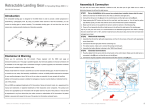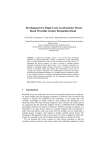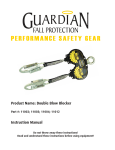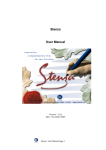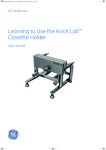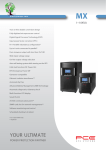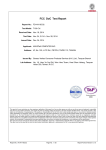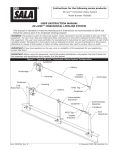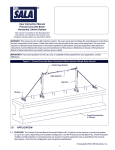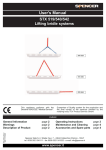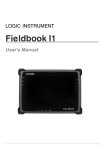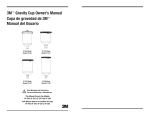Download Instruction manual.
Transcript
Rev 1/04 - 03 Safety Pole User Instruction Manual Safety Pole and Horizontal Lifeline System This manual is provided as the Manufacturer’s Instructions and should be used as part of an employee training program as required by OSHA. WARNING: This product is part of a fall protection system. The users must read and follow the manufacturer’s instructions for each component of the system. These instructions must be provided to the users of this equipment. The users must read and understand these instructions or have them explained to them prior to using the equipment. Manufacturer’s instructions must be followed for proper use and maintenance of this product. Alterations or misuse of this product or failure to follow instructions may result in serious injury or death. IMPORTANT: If you have questions on the use, care, or suitability of this equipment for your application, contact Safety Pole Inc. Figure 1 – Safety Pole 1a – first floor installation 1b – second floor installation Figure 2 – Safety Pole Horizontal Lifeline System 2a – Single story HLL installation 2b – second story HLL installation Figure 2a – Safety Pole Top View Tensioning Cables Rev 1/04 - 03 Figure 3 Safety Pole Base Installations Cement Base 3a) base to cement floor with 4 each 1/2 x 4 red-heads or 4 each 3/8 x 4 Simpson TITEN HD Anchors 1.0 3b) base to floor joists with adapter plate and 4 x j-bolts APPLICATION 1.1 PURPOSE: The Safety Pole System can be used as either a single pole anchoring point or as a Horizontal Lifeline (HLL) system during the framing of residential or commercial construction. The safety pole system is ideal for protecting workers from exterior and open two story interior falls (when using the interior catch cable, see section 3 for installation) during the installation of the 2nd floor or higher exterior walls and during the installation of roof trusses, sheathing and fascia. As a single anchoring point the Safety Pole can accommodate up to three workers. As a HLL the Safety Pole can accommodate up to 2 workers per HLL when the HLL’s are installed properly. See figures 1 and 2 for the configuration and component identification. 1.2 LIMITATIONS: The following limitations apply to the installation and use of this equipment. Other limitations may apply: IMPORTANT: OSHA regulations require that horizontal lifelines shall be installed and used under the supervision of a qualified person (see below for definition) as part of a complete personal fall arrest system that maintains a safety factor of at least two. Qualified Person: An individual with a recognized degree or professional certificate, and extensive knowledge and experience in the subject field, who is capable of design, analysis, evaluation and specification in the subject work, project or product. Refer to OSHA 1910.66, 1926.32 and 1926.502. A. B. HORIZONTAL LIFELINE: The horizontal lifeline must be engineered to limit the loads on the end anchors (Safety Poles) to 5,000 lbs. along the axis of the HLL and 3,600 lbs. in all potential directions of the fall arrest that are perpendicular to the axis of the HLL. The HLL must be located above the workers D-ring at all times to reduce the fall angle and limit the loads on the end anchors. HORIZONTAL LIFELINE SPAN: The maximum horizontal lifeline span is 60 feet with a single Zorbit HLL energy absorber, or 100 feet when a Zorbit HLL energy absorber is installed on each end of the system. The system length can be extended by using multiple spans. See figure 4. The span length must be reduced when the clearance is limited. See section 3.0 for clearance information. Figure 4 - Multiple Span System Rev 1/04 - 03 C. ANCHORAGES: The Safety Pole System must be installed on anchorages that meet the strength and size requirements as illustrated in figure 3. D. SYSTEM CAPACITY: The capacity of the single safety pole system is three workers. The capacity of the single span HLL system is two workers per HLL when the HLL’s are installed properly. The capacity of the multiple span system is up to 2 workers per line / per span with a maximum of up to six workers. The maximum weight of each person including tools and clothing is 310 lbs. E. CONNECTING SUBSYSTEM: Read and follow the connecting subsystem manufacturer’s instructions. A self retracting lifeline is to be used with the Safety Pole System to limit freefall distances and provide worker mobility. Each user’s connecting subsystem must limit the fall arrest forces to a maximum of 900 lbs. See section 2.4. Figure 5 – Swing Fall Hazard F. FREE FALL: Rig and use the personal fall arrest system such that the potential free fall does not exceed government Anchorage point regulatory and subsystem manufacturer’s requirements. See section 3.0 and subsystem manufacturer’s instructions for more information. G. SWING FALLS: See Figure 5. Swing falls occur when the anchorage point is not directly above the point where a fall occurs. The force of striking an object in a swing fall may cause serious injury or death. Minimize swing falls by working as close to the anchorage point as possible. Do not permit a swing fall if injury could occur. When protecting workers over interior two story openings, use the interior catch cable per section 3 to minimize swing falls. H. FALL CLEARANCE: There must be sufficient clearance below the worker to arrest a fall before striking a lower level or obstruction. See section 3.0 for required fall clearance information. I. BODY SUPPORT: This equipment must only be used with personal fall arrest systems incorporating a full body harness and a self retracting cable lifeline. J. PHYSICAL AND ENVIORNMENTAL HAZARDS: Use of this equipment in areas with physical or environmental hazards may require additional precautions to reduce the possibility of injury to the user or damage to the equipment. Hazards may include, but are not limited to; heat, chemicals, corrosive environments, high voltage power lines, gases, moving machinery, and sharp edges. Contact Safety Pole Inc. if you have questions about using this equipment where physical or environmental hazards exist. K. TRAINING: This equipment must be installed and used by persons trained in the correct application and use of this equipment. See section 4.0. 1.3 APPLICABLE STANDARDS: Refer to national standards, including ANSI Z359.1, ANSI A10.14 and local, state and federal (OSHA 1910.66 and 1926.502) requirements for more information on personal fall arrest systems and associated components. 2.0 SYSTEM REQUIREMENTS 2.1 COMPATIBILITY OF COMPONENTS: Safety Pole Inc equipment is designed for use with Safety Pole approved components and subsystems only. Substitutions or replacements made with non-approved components or subsystems may jeopardize compatibility of equipment and may affect the safety and reliability of the complete system. 2.2 COMPATIBILTIY OF CONNECTORS: Connectors are considered to be compatible with connecting elements when they are designed to work together in such a way that their sizes do not cause their gate mechanisms to inadvertently open regardless of how they become oriented. If the connecting element that a snap hook or carabineer attaches to is undersized or irregular in shape, a situation could occur where the connecting element applies a force to the gate of the snap hook or carabineer. This force may cause the gate (of either a self-locking or a non-locking snap hook) to open, allowing the snap hook or carabineer to disengage from the connecting point. Rev 1/04 - 03 Connectors (hooks, carabineers, and D-rings) must be capable of supporting at least 5,000 lbs. (22kN). Connectors must be compatible with the anchorage or other system components. Do not use equipment that is not compatible. Non-compatible connectors may unintentionally disengage. Connectors must be compatible in size, shape and strength. Self locking snap hooks and carabineers are required by ANSI Z359.1 and OSHA. 2.3 MAKING CONNECTIONS: Only use self-locking snap hooks and carabineers with this equipment. Only use connectors that are suitable to each application. Ensure all connections are compatible in size, shape and strength. Do not use equipment that is not compatible. Ensure all connectors are fully closed and locked. Snap hook and carabineers should not be connected: A. B. To a D-ring to which another connector is attached. In a manner that would result in a load on the gate. NOTE: Large throat opening snap hooks should not be connected to standard size D-rings or similar objects which will result in a load on the gate if the hook or D-ring twists or rotates. Large throat snap hooks are designed for use on fixed structure elements such as rebar or cross members that are not shaped in a way that can capture the gate of the hook. C. D. E. F. In a false engagement, where features that protrude from the snap hook or carabineer catch on the anchor and without visual confirmation seems to be fully engaged to the anchor point. To each other. Directly to webbing or rope lanyard or tie-back (unless the manufacturer’s instructions for both the lanyard and connector specifically allow such a connector). To any object which is shaped or dimensioned such that the snap hook or carabineer will not close and lock or roll-out could occur. 2.4 CONNECTING SUBSYSTEM: The connecting subsystem (cable self retracting lifeline) is the portion of the personal fall arrest system that is used to connect between the full body harness and the horizontal lifeline rollers. The connecting subsystem must limit forces applied to the horizontal lifeline to 900 lbs or less. 2.5 STRUCTURAL LOAD: Structural anchorage points must be rigid, and capable of supporting at least 5,000 lbs. along the axis of the horizontal lifeline. Anchorages must also support at least 3,600 lbs. applied in all directions of fall arrest that are perpendicular to the axis of the horizontal lifeline. See figure 8. 3.0 INSTALLATION AND USE WARNING: Do not alter or intentionally misuse this equipment. Consult Safety Pole Inc., when using this equipment in combination with components or subsystems other than those described in this manual. Some subsystem and component combinations may interfere with the operation of this equipment. Use caution when using this equipment around moving machinery, electrical hazards, chemical hazards and sharp edges. WARNING: Consult your doctor if there is reason to doubt your fitness to safely absorb the shock from a fall arrest. Age and fitness seriously affect a worker’s ability to withstand falls. Pregnant women and minors must not use this system. 3.1 BEFORE EACH USE inspect this equipment according to section 5.0. Do not use this equipment if the inspection reveals an unsafe or defective condition. Plan the use of your fall protection system prior to exposing workers to dangerous situations. Review all factors affecting your safety before using this system. A. Read and understand all manufacturers’ instructions for each component of the personal fall arrest system. B. Review sections 1.0 and 2.0 to ensure the system limitations and other requirement have been met. Review applicable information regarding the system clearance criteria and ensure changes have not been made to the system installation (such as span distance) or occurred at the job site that could affect the system performance. Do not use the system if changes are required. Rev 1/04 - 03 3.2 SYSTEM INSTALLATION: Figure 1, 2 and 3 illustrates a typical safety pole installation. Figure 4 illustrates a typical multi-span installation. The system must be installed and used as specified below. A. SYSTEM LOCATION: Install the safety pole system on the working surface level. The poles must be located at a height according to the clearance requirements in section 3.0 and so the HLL is located above the workers D-ring at all times to reduce the fall angle and limit the loads on the end anchors. The poles must be installed at approximately the same elevation. Limit the slope to five degrees or less. B. SYSTEM DIRECTION: The horizontal line must be installed straight and horizontal, without turns or bends. C. APPLICABLE SYSTEM AND BASE LOCATIONS: The system and base location is determined by reviewing the architectural drawings of the structure. Determine a location that has a clear passage, without mechanical interference, through to the roof and provides a maximum working area. If the HLL system will be installed as illustrated in figure 2, location of the bases should be determined to best meet the fall clearance requirements per the HLL manufacturer’s instructions. D. BASE ATTACHMENT: The base may be installed on a concrete floor or on a sub-floor. a. CONCRETE FLOORS: If installation is on a concrete floor, 4 each ½ x 4 inch Red-head anchor bolts will be required or 4 each 3/8 x 4 Simpson TITEN HD anchors, as illustrated in figure 3a, to maintain the location of the base. Locate the base in the appropriate location. Drill ½ holes through the four holes located in the base. Set the anchor bolts through the four base holes and into the concrete. Tighten the nuts on the anchor bolts to secure the base. Take into account any post-tensioning cables and/or plumbing in the concrete floor when locating the base by reviewing the approved building plans. Make sure the base is secure before proceeding. b. WOOD SUBFLOORS: If attaching to a wood sub-floor, the sub-floor attachment plate (Section 5), as illustrated in 3b, will be required. Drill holes into the sub-floor so that the 4 x safety pole j-bolts can be securely anchored to the floor joists. Secure the anchor plate by tightening the nuts on the j-bolts. Attach the safety pole base (unit 1) to the sub-floor base by sliding the base over the four threaded posts of the sub-floor attachment plate. Secure the safety pole base to the sub-floor attachment plate by tightening the 4 nuts provide onto the threaded posts of the sub-floor attachment plate. Make sure the base is secure before proceeding. Should the Safety Pole System exceed 32 feet in height, bracing will be required under the base. A 4 x 6 inch timber brace must be installed directly under the flooring and the safety pole base. The 4 x 6 inch timber must extend directly under the safety pole base to a concrete footing or concrete floor. E. SYSTEM INSTALLATION a. SINGLE STORY STRUCTURE: i. Once the base(s) is securely installed, install the first ten foot section of the safety pole (Section 2) by lifting and sliding the section onto the base. The pole is fully engaged when it is upright and fully inserted on the base. It is recommended that the pole be lifted using two workers or with one worker and a lifting machine such as a fork lift. Beware of pinching fingers or straining backs when lifting and sliding sections of the safety pole. ii. Next on the ground slide the T (Section 4) on to the five foot section (Section 3). Using a fork lift, raise the two sections using the lifting ring of the five foot section (Section 3) and slide on to the ten foot section (Section 2). Install the five foot section (section 3) into the existing ten foot section by sliding the five foot section into the ten foot section. The five foot section is fully engaged when it is upright and fully inserted into the ten foot section. iii. If you are installing the HLL system, repeat this process of installing the second and third sections (Section 3 and 4) on the connecting or second safety pole, including the installation of the side steadying cables. Once the two independent safety poles have been fully installed you are ready to install the HLLs. Rev 1/04 - 03 Figure 6 – Plate Shoe iv. v. Attach, as illustrated in figure 2a, the 3 side steadying cables. Install the 3 side steadying cables on back (opposite side from the HLL) and two sides of each safety pole section (Section 2). 1. First attach the appropriate plate shoes for either 2x4 (Section 7), 2x6 (Section 8), or 3x4 (Section 9) to the exterior wall sil-plates. Secure the plate shoes through the pre-drilled holes using 6 standard 10d common nails, as illustrated in figure 6. Make sure they are securely attached to the sil-plate. 2. Locate and attach the tensioning cables (Part Number 10) to the D-ring located on the section of the safety pole directly below the top tee section of the safety pole (Section 4). Attach the other end of the tensioning cables to the Plate Shoes. String together tensioning cables, if more than one tensioning cable is required to reach the plate shoe. Tighten the tensioning cable to provide steady tension by tightening the Exterior wall sil-plate tensioning cable winch. Repeat this process for the other tensioning cables. If you are installing a HLL, do not tighten the back tensioning cable at this point. The tensioning cables should not exceed a 45 degree angle above the floor. Figure 2.0 illustrates a typical HLL Safety Pole installation. The HLL and end anchors must be located above the users at all times to reduce the loads on the end anchors. The Self retracting Lifeline, when fully retracted, must be above the harness attachment level. The HLL must be positioned to minimize the swing fall and free fall. The fall clearance in figure 7 must also be taken into account when positioning the HLL. 1. Install the HLL to the anchorage connectors using the double locking carabineers as illustrated in figure 8. 2. Remove the excess slack by pulling the wire rope through the cable grip. The jaw release bolt must be extended, as illustrated in figure 9, allowing the jaws to tighten around the wire rope, holding the wire rope tight. 3. Tighten the wire rope until the sag at the system mid span is 6 inches or less, with no weight on the wire rope, by tightening the steadying cable on the backside of the Safety Poles. Rev 1/04 - 03 Figure 7 – Fall Clearance Evaluation Span Length WARNING: This information only applies when the HLL and SRL are located overhead and above the level of the harness attachment point and the user is standing. Required clearance from the nearest lower level or obstruction to working level: 1. Find your system span length row in the clearance table. 2. Read the required clearance distance from the distance column to determine if adequate clearance exists in the event of a fall. If there is inadequate clearance, do not use the system, or reduce your span length and reevaluate your required clearance. Clearance Table Working Level Lower Level or Obstruction Span Length (in Feet) >0 but≤10 10 – 20 20 – 30 30 – 40 40 – 50 50 – 60 60 – 70 70 – 80 80 – 90 90 – 100 Required Distance 6’ – 11” 8’ – 0” 9’ – 1” 10’ – 2” 11’ – 4” 12’ – 5” 13’ – 6” 14’ – 7” 15’ – 8” 16’ – 10” Rev 1/04 - 03 Figure 8 – Horizontal Lifeline Safety Pole T-Anchors Carabineer Safety Pole T-Anchors Wire Rope Turnbuckle Cable Grab 5,000 lbs. Minimum Zorbit Shock Absorber Carabineer 5,000 lbs. Minimum 3600 lbs. Minimum (in all potential directions of fall arrest applied loading) Figure 9 - Cable Grip HLL Cable Cable Grip Release Bolt Cable Grip Body HLL Cable Connection Point to Zorbit Shock Absorber To release the HLL cable and cable grip jaws turn the release bolt clockwise. To grip the HLL cable turn the release bolt counter clockwise until jaws firmly grip the HLL cable and the HLL cable will not slip out of the cable grip. b. MUTLI-STORY STRUCTURE: i. Once the base(s) is securely installed, install the first ten foot section of the safety pole (Section 1) by lifting and sliding the section onto the base. The pole is fully engaged when it is upright and fully inserted on the base. It is recommended that the pole be lifted using two workers or with one worker and a lifting machine such as a fork lift. Beware of pinching fingers or staining backs when lifting and sliding sections of the safety pole. ii. Sheet the floor around the ten foot section (Section 1) of the Safety Pole as tightly as possible (within a maximum of ¼ inch) using plywood flooring. iii. If you are using the safety pole for work installing the exterior walls of a multi-story structure, as illustrated in figure 1a, the system must be installed and used as specified below. Rev 1/04 - 03 1. iv. Next on the ground slide the T (Section 4) on to the five foot section (Section 3). Using a fork lift, raise the two sections using the lifting ring of the five foot section (Section 3) and slide on to the ten foot section (Section 2). Install the five foot section (section 3) into the existing ten foot section by sliding the five foot section into the ten foot section. The five foot section is fully engaged when it is upright and fully inserted into the ten foot section. 2. If you are installing the HLL system, repeat this process of installing the second and third sections on the connecting or second safety pole. Once the two independent safety poles have been fully installed you are ready to install the HLLs. 3. Figure 2.0 illustrates a typical HLL Safety Pole installation. The HLL and end anchors must be located above the users at all times to reduce the loads on the end anchors. The Self retracting Lifeline, when fully retracted, must be above the harness attachment level. The HLL must be positioned to minimize the swing fall and free fall. The fall clearance in figure 7 must also be taken into account when positioning the HLL. a. Install the HLL to the anchorage connectors using the double locking carabineers as illustrated in figure 8. b. Remove the excess slack by pulling the wire rope through the cable grip. The jaw release bolt must be extended, as illustrated in figure 9 allowing the jaws to tighten around the wire rope, holding the wire rope tight. c. Tighten the wire rope until the sag at the system mid span is 6 inches or less, with no weight on the wire rope, by tightening the steadying cable on the backside of the Safety Poles. If you are using the Safety Pole System when installing roof trusses, roof sheathing and fascia on a second story structure as illustrated in figure 2b the system must be installed and used as specified below. The safety pole when completely installed must be at least three feet above the top of the roof line. Install extra sections as required to meet the height. 1. After the completion of installing the exterior walls of the second floor, disassemble the HLL’s, by reducing the tension on the back steadying cable and unclipping the carabineers from the Safety Pole System. Continue the disassembly process by lifting the Safety Pole (Sections 3 and 4) by using the lifting ring on the five foot section (Section 3) out of the ten foot sections (Section 1). At this point you are ready to reassemble the Safety Pole System to install roof trusses, roof sheathing and fascia on a second story structure. 2. Using a fork lift, lift the ten foot section (Section 2) to the second floor. Lift and slide the ten foot section (Section 2) onto the existing installed ten foot section (Section 1). Section 2 is fully engaged when it is upright and fully inserted into the existing ten foot section. 3. Next on the ground slide the T (Section 4) on to the five foot section (Section 3). Using a fork lift, raise the two sections using the lifting ring of the five foot section (Section 3) and slide on to the ten foot section (Section 2). Install the five foot section (section 3) into the existing ten foot section by sliding the five foot section into the ten foot section. The five foot section is fully engaged when it is upright and fully inserted into the ten foot section. 4. Repeat this process for the second Safety Pole to be able to install HLLs. 5. Attach, as illustrated in figure 2a, the 3 side steadying cables. Install the 3 side steadying cables on back (opposite side from the HLL) and two sides of each safety pole section (Section 2). a. First attach the appropriate plate shoes for either 2x4 (Section 7), 2x6 (Section 8), or 3x4 (Section 9) to the exterior wall sil-plates. Secure the plate shoes through the pre-drilled holes using 6 standard 10d common nails, as illustrated in figure 6. Make sure they are securely attached to the sil-plate. b. Locate and attach the tensioning cables (Part Number 10) to the D-ring located on the section of the safety pole directly below the tee section of the safety pole (Section 4). Attach the other end of the tensioning cables to the Plate Shoes. String together tensioning cables, if more than one tensioning cable is required to reach the plate shoe. Tighten the tensioning cable to provide steady tension by tightening the tensioning cable winch. Repeat this process for the other tensioning cables. If you are installing a HLL, do not tighten the back tensioning cable at this point. The tensioning cables should not exceed a 45 degree angle above the floor. Rev 1/04 - 03 6. 7. Figure 2.0 illustrates a typical HLL Safety Pole installation. The HLL and end anchors must be located above the users at all times to reduce the loads on the end anchors. The Self retracting Lifeline, when fully retracted, must be above the harness attachment level. The HLL must be positioned to minimize the swing fall and free fall. The fall clearance in figure 7 must also be taken into account when positioning the HLL. a. Install the HLL to the anchorage connectors using the double locking carabineers as illustrated in figure 8. b. Remove the excess slack by pulling the wire rope through the cable grip. The jaw release bolt must be extended, as illustrated in figure 9, allowing the jaws to tighten around the wire rope, holding the wire rope tight. c. Tighten the wire rope until the sag at the system mid span is 6 inches or less, with no weight on the wire rope, by tightening the steadying cable on the backside of the Safety Poles. To prevent interior swing falls over open two story interior rooms, the installation of an interior catch cable is required between the overhead horizontal lifeline and the exterior working/walk surface as illustrated in figure 10. To install the interior catch cable, install two plate shoes using 6 x 10d common nails to the top plate at five feet in from the working/walking surface. Attach the 3/8 inch diameter steel horizontal cable to the plate shoes with the carabineers, so that the cable is running parallel to the working/walk surface. Tension the cable by pulling it through the cable grip so that there is no sag in the middle of the line. If a fall should occur to the interior, the catch cable will prevent a swing fall to directly below the overhead horizontal cable. Figure 10 – Interior Catch Cable Exterior working/walk surface Safety Pole HLLs Interior two story opening Plate Shoes 5 feet Top-down view of working area Catch cable Warning – Whenever the safety pole is raised to the next level the tensioning cables must also be re-attached to the DRings just below the top 5 foot section of the Safety Pole. The side tensioning cables must never exceed a 45 degree angle above the floor. 3.3 OPERATION: A. B. PERSONAL FALL ARREST SYSTEM COMPONENTS: Inspect and don the full body harness according to the manufacturer’s instructions. Attach the connecting subsystem to the D-ring connection on the harness. CONNECTING TO THE HLL SYSTEM: Approach the work area using the appropriate access equipment. Connect the personal fall arrest system to one of the attachment rollers on the HLL. Connectors must meet all compatibility and strength requirements. Rev 1/04 - 03 C. HAZARDOUS SITUATIONS: Do not take unnecessary risks, such as jumping or reaching too far from the edge of the working surface. Do not allow the connecting subsystem to pass under arms or between feet. To avoid inadequate clearance, do not climb above the HLL. To avoid swing fall hazards, do not work too far from either side of the HLL. D. TWO PERSONS CONNECTED TO EACH HLL: When a person falls while connected to the HLL, the system will deflect. If two persons are connected to the same HLL, and one person falls, the second person may be pulled off the working surface due to deflection. The potential for the second person falling increases as the HLL span length increases. The use of independent HLL systems for each person, or shorter span length, is recommended to minimize the potential of the second person falling. E. FREE FALL: The personal fall arrest system must be rigged so that the SRL or shock absorbing lanyard is overhead and without slack, according to OSHA requirements. F. SHARP EDGES: Avoid working where the connecting subsystem or other system components will be in contact with, or abrade against, unprotected sharp edges. If working around sharp edges is unavoidable, a protective cover must be used to prevent cutting of the PFAS components. G. IN THE EVENT OF A FALL: The responsible party must have a rescue plan and the ability to implement a rescue. Tolerable suspension time in a full body harness is limited, so a prompt rescue is critical. IMPORTANT: Use care when handling an expended energy absorber. The tearing of the energy absorber material produces extremely sharp edges. Handle the expended energy absorber per the HLL manufacturer’s instructions H. RESCUE: With the number of potential scenarios for a worker requiring rescue, an on site rescue team is beneficial. The rescue team is given the tools, both in equipment and techniques, so it can perform a successful rescue. Training should be provided on a periodic basis to ensure rescuers proficiency. 3.4 DISASSEMBLY OF THE SYSTEM: When dismantling the Safety Pole System the following steps are recommended. A. TIE-OFF TO PERMENTALLY INSTALLED ROOF ANCHORS: When standing on the roof of the structure and disassembling the Safety Pole System it is strongly recommended that the worker wear a fall protection full body harness that meets OSHA requirements and anchor to a permanently installed roof anchor with a shock absorbing lifeline. B. DISASSEMBLING THE HLL: Disassemble the HLL’s, by reducing the tension on the back steadying cable and unclipping the carabineers from the Safety Pole System. C. REMOVE THE T- SECTION(S) AND THE FIVE FOOT SECTION: Continue the disassembly process by lifting the Safety Pole T-section(s) (Section 4) and the five foot section(s) out of the ten foot Safety Pole sections (Part Number 2 or 1). The simplest way to lift these sections is by the lifting D-Ring on the five foot section (Section 3) with a fork lift. Lower the sections to the ground. D. REMOVE THE TENSIONING CABLES: From inside the structure, continue the disassembly process by removing the tensioning cables and attachment brackets. E. REMOVE THE TEN FOOT SECTIONS: From inside the structure continue the disassembly of the ten foot sections by sliding them apart. F. REMOVE THE BASE: Loosen the nuts from the bolts around the base and remove the base. If you used permanent anchor bolts, cut the bolts off flush with the surface of the structure. 4.0 TRAINING: 4.1 It is the responsibility of all users of this equipment to understand these instructions and be trained in the correct installation, use, and maintenance of this equipment. These individuals must be aware of the consequences of improper installation or use of this equipment. This user’s manual is not a substitute for a comprehensive training program. Training must be provided on a periodic basis to ensure proficiency of the users. 5.0 INSPECTION: 5.1 BEFORE EACH INSTALLATION: Inspect the HLL energy absorber, kit components, and other system components according to these and other manufacturer’s instructions. System components must be formally inspected by a qualified person (other than the user) at least annually. Formal inspection Rev 1/04 - 03 should concentrate on visible signs of deterioration or damage to the system components. Items found to be defective must be replaced. Do not use components if inspection reveals an unsafe or defective condition. Record results of each inspection in the inspection and maintenance log in section 9.0 of this manual. 5.2 INSTALLED SYSTEMS: An inspection of the Safety Pole and HLL system by a qualified person must be completed after the system is installed. The system must be periodically inspected by a qualified person when left installed for an extended period and prior to each day’s use. Periodic inspections should be performed at least monthly or more frequently when site conditions and use warrant. Inspections of installed systems should include the inspection steps listed in section 5.3. 5.3 BEFORE EACH USE: A. Inspect the turnbuckle for damage. Ensure sufficient threads are engaged into the turnbuckle body. Look for any cracks or deformations in the metal. Inspect metal components for rust or corrosion that may affect their strength or operation. B. Inspect the cable for rust, corrosion, broken wires, or obvious faults. Inspect the HLL and side tensioning cables for proper tension. Inspect all hardware (fasteners, shackles, wire rope clips, etc.) securing the HLL and tensioning cable assemblies to ensure they are present and properly installed. C. Inspect the HLL energy absorber for extension or deformities. There should be no tearing of the metal between the holes in the coiled section. D. Inspect securing hardware and the Safety Poles for strength and function. E. Inspect system labels. The labels must be present and fully legible. See section 8.0. Replace labels missing or illegible. 5.4 UNSAFE OR DEFECTIVE EQUIPMENT: If inspection reveals an unsafe or defective condition, remove the unit from service. These items should be removed and returned to the manufacturer for repair if possible. 5.5 USER EQUIPMENT: Inspect full body harness and cables SRLs used in conjunction with the Safety Pole System according to the manufacturer’s instructions. 6.0 MAINTENANCE, SERVICE, STORAGE 6.1 SAFETY POLE SYSTEM: The safety pole system does require scheduled maintenance other than repair or replacement of items found defective during inspection. See section 5.0. If components become heavily soiled with grease, paint, or other substances clean with appropriate cleaning solutions. Do not use caustic chemicals that could damage system components. 6.2 USER EQUIPMENT: Maintain service and store user equipment according to manufacturer’s instructions. 7.0 SPECIFICATIONS: 7.1 MATERIALS: A. B. C. Residential System i. Safety Pole: 5X5x1/4 inch steel ii. Tensioning Cables: 10’ 1400 lb. working load ¼” steel cable iii. Tensioning Cable Ratchets: 8,000 lb. double pulley cable winch puller with ¼ inch steel cable iv. Base plate shoes: 3/16 inch steel Commercial System: i. Safety Pole: 5X5x5/16 inch steel ii. Tensioning Cables: 10’ 2,200 lb. working load, 11,000 lb. breaking limit ¼” steel cable iii. Tensioning Cable Ratchets: 8,000 lb. double pulley cable winch puller with ¼ inch steel cable iv. Base plate shoes: 3/16 inch steel Horizontal Lifeline: i. Wire Rope: 3/8 inch diameter, 7 x 19 galvanized steel ii. Bolts: Grade 5 or grade 8 zinc plated steel iii. Nuts: Zinc plated steel iv. Shackles: Galvanized steel, 5,000 lb. minimum tensile strength v. Thimbles: Galvanized steel vi. Turnbuckles: Galvanized steel, 5,000lb. minimum tensile strength Rev 1/04 - 03 D. vii. Cable Grip: Galvanized steel viii. Carabineers: 5,000 lb carabineers, double locking ix. Energy Absorber: Stainless Steel Catch Cable: i. Wire Rope: 3/8 inch diameter, 7 x 19 galvanized steel ii. Base Plate Shoes: 3/16 inch steel iii. Wire Rope: 3/8 inch diameter, 7 x 19 galvanized steel iv. Bolts: Grade 5 or grade 8 zinc plated steel v. Nuts: Zinc plated steel vi. Shackles: Galvanized steel, 5,000 lb. minimum tensile strengthThimbles: Galvanized steel vii. Turnbuckles: Galvanized steel, 5,000lb. minimum tensile strength viii. Cable Grip: Galvanized steel ix. Carabineers: 5,000 lb carabineers, double locking 8.0 LABELING 8.1 These labels must be present and fully legible: Rev 1/04 - 03 9.0 INSPECTION AND MAINTENANCE LOG DATE OF MANUFACTURE: ____________________________________________________________________ MODEL NUMBER: ____________________________________________________________________________ DATE PURCHASED: __________________________________________________________________________ INSPECTION DATE Approved By: Approved By: Approved By: Approved By: Approved By: Approved By: Approved By: Approved By: Approved By: Approved By: Approved By: Approved By: Approved By: Approved By: Approved By: Approved By: Approved By: Approved By: Approved By: Approved By: Approved By: Approved By: Approved By: Approved By: Approved By: INSPECTION ITEMS NOTED CORRECTIVE ACTION MAINTENANCE PERFORMED














